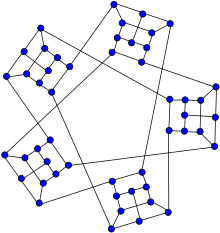In the mathematical field of graph theory, the Watkins snark is a snark with 50 vertices and 75 edges.[1][2] It was discovered by John J. Watkins in 1989.[3]
| Watkins snark | |
|---|---|
 The Watkins snark | |
| Named after | J. J. Watkins |
| Vertices | 50 |
| Edges | 75 |
| Radius | 7 |
| Diameter | 7 |
| Girth | 5 |
| Automorphisms | 5 |
| Chromatic number | 3 |
| Chromatic index | 4 |
| Book thickness | 3 |
| Queue number | 2 |
| Properties | Snark |
| Table of graphs and parameters | |
As a snark, the Watkins graph is a connected, bridgeless cubic graph with chromatic index equal to 4. The Watkins snark is also non-planar and non-hamiltonian. It has book thickness 3 and queue number 2.[4]
Another well known snark on 50 vertices is the Szekeres snark, the fifth known snark, discovered by George Szekeres in 1973.[5]
Gallery
edit-
The chromatic number of the Watkins snark is 3.
-
The chromatic index of the Watkins snark is 4.
Edges
edit[[1,2], [1,4], [1,15], [2,3], [2,8], [3,6], [3,37], [4,6], [4,7], [5,10], [5,11], [5,22], [6,9], [7,8], [7,12], [8,9], [9,14], [10,13], [10,17], [11,16], [11,18], [12,14], [12,33], [13,15], [13,16], [14,20], [15,21], [16,19], [17,18], [17,19], [18,30], [19,21], [20,24], [20,26], [21,50], [22,23], [22,27], [23,24], [23,25], [24,29], [25,26], [25,28], [26,31], [27,28], [27,48], [28,29], [29,31], [30,32], [30,36], [31,36], [32,34], [32,35], [33,34], [33,40], [34,41], [35,38], [35,40], [36,38], [37,39], [37,42], [38,41], [39,44], [39,46], [40,46], [41,46], [42,43], [42,45], [43,44], [43,49], [44,47], [45,47], [45,48], [47,50], [48,49], [49,50]]
References
edit- ^ Weisstein, Eric W. "Watkins Snark". MathWorld.
- ^ Watkins, J. J. and Wilson, R. J. "A Survey of Snarks." In Graph Theory, Combinatorics, and Applications (Ed. Y. Alavi, G. Chartrand, O. R. Oellermann, and A. J. Schwenk). New York: Wiley, pp. 1129-1144, 1991
- ^ Watkins, J. J. "Snarks." Ann. New York Acad. Sci. 576, 606-622, 1989.
- ^ Wolz, Jessica; Engineering Linear Layouts with SAT. Master Thesis, University of Tübingen, 2018
- ^ Szekeres, G. (1973). "Polyhedral decompositions of cubic graphs". Bull. Austral. Math. Soc. 8 (3): 367–387. doi:10.1017/S0004972700042660.